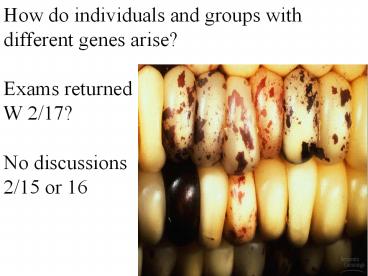How do individuals and groups with different genes arise? - PowerPoint PPT Presentation
Title:
How do individuals and groups with different genes arise?
Description:
How do individuals and groups with different genes arise? Exams returned W 2/17? No discussions 2/15 or 16 DNA Composition: In humans: Each cell contains ~6 billion ... – PowerPoint PPT presentation
Number of Views:53
Avg rating:3.0/5.0
Title: How do individuals and groups with different genes arise?
1
How do individuals and groups with different
genes arise? Exams returnedW 2/17? No
discussions2/15 or 16
2
Fig 5.26
Information flow in cells
Protein
3
Fig 13.5
As organisms reproduce the DNA is passed on to
the next generations.
4
Only a small percent of DNA codes for proteins
Fig 21.7
5
DNA Composition
- In humans
- Each cell contains 6 billion nucleotides of DNA.
- This DNA is 2 meters long and 2 nm wide.
- 98 does not directly code for amino acids
- In a single human cell only about 5-10 of genes
are expressed at a time.
6
Fig 6.2
Length of human DNA in each cell
The length of DNA in each of your cells is longer
than you are tall.
Width of DNA
Power of ten http//www.youtube.com/watch?vA2cml
hfdxuY
7
DNA Composition
- In humans
- Each cell contains 6 billion base pairs of DNA.
- This DNA is 2 meters long and 2 nm wide.
- 1.5 directly codes for amino acids
- 25 is genes
- In a single human cell only about 5-10 of genes
are expressed at a time.
8
fig 21.7
Genes are replicators (selfish gene)
9
fig 19.4
Viruses infect living cells, take over, and
produce more virus.
10
Bodies are vessels for the transmission of genes
11
fig 21.8
Transposons
12
fig 21.9
Genes are replicators (selfish gene) Transposons
mobile DNA
13
fig 21.8
Barbara McClintock, discoverer of transposons
14
fig 21.8
Transposons
15
transposase
transposon
16
(No Transcript)
17
(No Transcript)
18
(No Transcript)
19
(No Transcript)
20
fig 21.9
Genes are replicators (selfish gene) Transposons
mobile DNA
21
Retrotransposons mobile and self-replicating DNA
fig 21.9
22
fig 21.7
Genes are replicators (selfish gene)
23
Evolution A species genetic component changes
as the individuals reproduce. These changes are
based on how the DNA changes and who reproduces.
24
Reproductive success evolutionary success
25
Reproductive success Evolutionary success
26
Reproductive success Evolutionary success
www.jayhosler.com
27
Reproductive success evolutionary success
28
Are genes the only replicators?
29
Memes transmissible ideas
- Ideas can act similarly to genes
- Contain information
- Replicate with imperfect fidelity
30
Mutations
31
Memes transmissible ideas
- Ideas can act similarly to genes or viruses
- Contain information
- Replicate with imperfect fidelity
32
Memes transmissible ideas
- Ideas can act similarly to genes or viruses
- Contain information
- Replicate with imperfect fidelity
Evolve most successful replicators become most
abundant
33
Contrasts between memes and genes
- Genes
- Slow replication
- High copy fidelity
- Universal in organisms
- Memes
- Rapid replication
- Low copy fidelity
- Limited to some organisms
- Only humans can transmit complex memes?
34
Humans can pass on genes and/or memes
35
Evolution of memes and genes
Selection of memes and genes can be at odds
NvN chpt 8
36
Do other animals have culture?
In rats
http//salmon.psy.plym.ac.uk/year3/PSY339Evolution
aryPsychology/EvolutionaryPsychology.htm
37
Do other animals have culture?
http//www.pbs.org/saf/1504/video/watchonline.htm
38
Do memes make humans unique?
39
Evolution A species genetic component changes
as the individuals reproduce. These changes are
based on how the DNA changes and who reproduces.
40
How do individuals and groups with different
genes arise? Exams returnedW 2/17? No
discussions2/15 or 16































